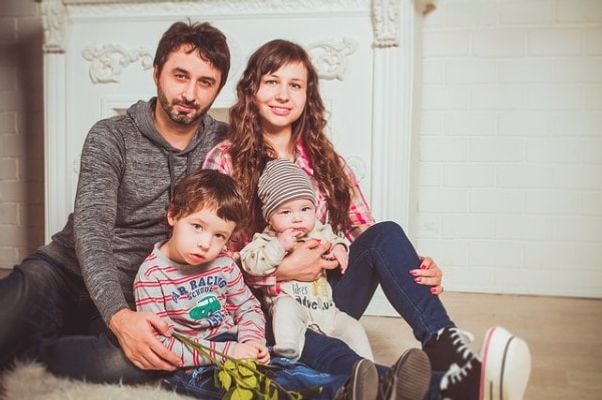1.1.3
Cambios en la familia
Cambios en la Familia
Cambios en la Familia


La familia nuclear tradicional
La familia nuclear tradicional
- ¿Qué tipos de modelos familiares son comunes hoy en día?
- What types of family models are common today?


Los modelos familiares
Los modelos familiares
- Hoy en día existen muchos más tipos de modelos familiares que hace 70 años, cuando la familia nuclear tradicional, compuesta por un padre, una madre y los hijos, era único modelo familiar .
- There are many more types of family models today than there were 70 years ago, when the traditional nuclear family, made up of a father, a mother and children, was the only family model.


Familias hoy en día
Familias hoy en día
- En la actualidad es fácil encontrar muchos tipos de modelos familiares.
- Today it is easy to find many types of family models.


Familias monoparentales
Familias monoparentales
- Por ejemplo, tenemos las familias monoparentales, en las que los hijos viven con el padre o con la madre.
- For example, we have single-parent families, in which the children live either with the father or with the mother.


Familias hoy en día
Familias hoy en día
- También tenemos las familias ensambladas, en las que dos adultos conviven formando una familia con al menos un hijo de una relación anterior.
- We also have 'assembled families', in which two adults live together and form a family with at least one child from a previous relationship.


Otras familias
Otras familias
- Además es bastante común en la actualidad encontrar familias en las que los padres no están casados.
- Furthermore, it is quite common nowadays to find families in which the parents are not married.


La dictadura franquista
La dictadura franquista
- Durante la dictadura franquista, estos tipos de familias habrían impensables ya que la sociedad no veía con buenos ojos los modelos de familia no tradicional, que serían “señalados”.
- During the Franco dictatorship these types of families would have been unthinkable since society did not regard well non-traditional families, which were “singled out".


Los cambios en los últimos 70 años
Los cambios en los últimos 70 años
- ¿Qué dos películas españolas conocidas crees que podrían ilustrar los cambios en la familia de los últimos 70 años?
- Which two well-known Spanish films do you think could illustrate the changes in the family of the last 70 years?


Películas
Películas
- Para poder ilustrar estos cambios, podríamos usar dos películas que reflejan bien la familia de hoy en día por un lado, y la de la sociedad franquista por otro.
- In order to illustrate these changes, we could use two films that reflect well today's family on the one hand, and the family of the Francoist society on the other.


La familia en 'Ocho Apellidos Vascos'
La familia en 'Ocho Apellidos Vascos'
- En primer lugar se podría usar “Ocho apellidos vascos”. En esta peli vemos la familia de Amaya, una chica joven e independiente que trabaja como taxista fuera de casa. Sus padres están divorciados.
- Firstly, we could use “Eight Basque surnames”. In this film we see the family of Amaya, a young and independent girl who works as a taxi driver away from home. Her parents are divorced.


La familia en 'El laberinto del Fauno'
La familia en 'El laberinto del Fauno'
- Mientras tanto, en “El laberinto del fauno”, ambientada en el año 1944, la protagonista principal es una niña que vive con su madre y su padrastro Vidal, que es machista y autoritario.
- On the other hand, in "El laberinto del fauno", set in 1944, the main protagonist is a girl who lives with her mother and her stepfather Vidal, who is chauvinist and authoritarian.


La familia en 'El laberinto del Fauno'
La familia en 'El laberinto del Fauno'
- La madre viuda es una ama de casa que se casó con Vidal porque necesitaba seguridad y un hombre que la protegiera. Esto refleja bien el papel sumiso de la mujer durante la dictadura franquista.
- Her widowed mother is a housewife who married Vidal because she needed security and a man who could protect her. This reflects well the submissive role of women during the Franco dictatorship.
1Los valores tradicionales y modernos
1.1Los cambios en la familia
1.2Actitudes hacia el matrimonio/el divorcio
2El ciberespacio
2.1La influencia de internet
2.2Las redes sociales: beneficios y peligros
3La igualdad de los sexos
3.1La mujer en el mercado laboral
3.2El machismo y el feminismo
4La inmigración
4.1Los beneficios y los aspectos negativos
4.2La inmigración en el mundo hispánico
5El racismo
5.1Las actitudes racistas y xenófobas
5.2Las medidas contra el racismo
6La convivencia
6.1La convivencia de culturas
6.2La educación
7La influencia de los ídolos
7.1Cantantes y músicos
7.2Estrellas de televisión y cine
8La identidad regional en España
8.1Tradiciones y costumbres
8.2La gastronomía
9El patrimonio cultural
9.1Sitios turísticos y civilizaciones prehispánicas
9.2Arte y arquitectura
10El Laberinto del Fauno
10.1Temas
10.2Marco histórico
10.3Personajes
11Nouns
11.1Singular & Plural Forms
11.3Affective Suffixes
12Articles
12.1Definite & Indefinite
12.2El with Feminine Nouns
12.3Lo + Adjective
13Adjectives
13.1Agreement
13.2Position
13.4Comparative & Superlative
13.5Use of Adjectives as Nouns
13.6Demonstrative
13.7Indefinite
13.8Possessive
13.9Interrogative & Exclamative
13.10Relative
14Numerals & Quantifiers
14.1Cardinal
14.2Ordinal
14.3Agreement
14.4Expressions of Time and Date
14.5Quantifiers
15Pronouns
15.1Object: Direct & Indirect
15.2Reflexive
15.3Unstressed & Stressed Forms
15.4Position & Order
15.5Relative
15.6Demonstrative
15.7Indefinite
15.8Possessive
15.9Interrogative
16Verbs
16.1Regular Conjunctions
16.2Regular & Irregular Verbs
16.3Agreement of Verb & Subject
16.4Use of Hay Que in All Tenses
16.5Present Tense
16.6Preterite Tense
16.6.1Irregular IR Verbs - Decir, Venir & Ir
16.6.2Irregular ER Verbs 2
16.6.3Irregular AR Verbs
16.6.4Regular IR Verbs
16.6.5Irregular AR Verbs 2
16.6.6Irregular IR Verbs 3
16.6.7Regular ER Verbs
16.6.8Irregular ER Verbs
16.6.9Irregular IR Verbs - Preterite
16.6.10Regular AR Verbs
16.6.11Irregular ER Verbs - Ver & Tener
16.7Imperfect Tense
16.8Future Tense
16.9Conditional Tense
16.10Perfect Tense
16.11Future Perfect Tense
16.12Conditional Perfect Tense
16.13Pluperfect Tense
16.14Infinitive, Gerund & Past Participle
16.15Verbal Paraphrases
16.16Use of the Subjunctive
16.17Commands
16.18Conditional Sentences
16.19After Conjunctions of Time
16.20After Para Que, Sin Que
16.21In Relative Clauses
16.22After Other Subordinating Conjunctions
16.23With Verbs of Wishing & Commanding
16.24Sequence of Tense in Indirect Speech
16.25Voice
16.26Use of the Reflexives as a Passive
16.27Use of the Reflexive to Express an Impersonal
16.28Use of Ser + Past Participle
16.29Use of Estar + Past Participle
16.30'Nuance' Reflexive Verbs
16.31Modes of Address
16.32Constructions with Verbs
16.33Verbs Followed by an Infinitive
17Prepositions & Conjunctions
17.1All Prepositions
17.2'Personal' a
17.3Discrimination of Por and Para
17.4Coordinating Conjunctions
17.5Subordinating Conjunctions
17.6Use of Que to Introduce a Clause
18Negation, Questions & Commands
18.1Negation
19Word Order, Other Constructions & Discourse Marker
19.1Subject Following Verb
19.2Focalisation
19.3Time Expressions with Hace/Hacía
19.4Cleft Sentences
19.5Comparative Constructions
19.6Indirect Speech
19.7Discourse Markers
Jump to other topics
1Los valores tradicionales y modernos
1.1Los cambios en la familia
1.2Actitudes hacia el matrimonio/el divorcio
2El ciberespacio
2.1La influencia de internet
2.2Las redes sociales: beneficios y peligros
3La igualdad de los sexos
3.1La mujer en el mercado laboral
3.2El machismo y el feminismo
4La inmigración
4.1Los beneficios y los aspectos negativos
4.2La inmigración en el mundo hispánico
5El racismo
5.1Las actitudes racistas y xenófobas
5.2Las medidas contra el racismo
6La convivencia
6.1La convivencia de culturas
6.2La educación
7La influencia de los ídolos
7.1Cantantes y músicos
7.2Estrellas de televisión y cine
8La identidad regional en España
8.1Tradiciones y costumbres
8.2La gastronomía
9El patrimonio cultural
9.1Sitios turísticos y civilizaciones prehispánicas
9.2Arte y arquitectura
10El Laberinto del Fauno
10.1Temas
10.2Marco histórico
10.3Personajes
11Nouns
11.1Singular & Plural Forms
11.3Affective Suffixes
12Articles
12.1Definite & Indefinite
12.2El with Feminine Nouns
12.3Lo + Adjective
13Adjectives
13.1Agreement
13.2Position
13.4Comparative & Superlative
13.5Use of Adjectives as Nouns
13.6Demonstrative
13.7Indefinite
13.8Possessive
13.9Interrogative & Exclamative
13.10Relative
14Numerals & Quantifiers
14.1Cardinal
14.2Ordinal
14.3Agreement
14.4Expressions of Time and Date
14.5Quantifiers
15Pronouns
15.1Object: Direct & Indirect
15.2Reflexive
15.3Unstressed & Stressed Forms
15.4Position & Order
15.5Relative
15.6Demonstrative
15.7Indefinite
15.8Possessive
15.9Interrogative
16Verbs
16.1Regular Conjunctions
16.2Regular & Irregular Verbs
16.3Agreement of Verb & Subject
16.4Use of Hay Que in All Tenses
16.5Present Tense
16.6Preterite Tense
16.6.1Irregular IR Verbs - Decir, Venir & Ir
16.6.2Irregular ER Verbs 2
16.6.3Irregular AR Verbs
16.6.4Regular IR Verbs
16.6.5Irregular AR Verbs 2
16.6.6Irregular IR Verbs 3
16.6.7Regular ER Verbs
16.6.8Irregular ER Verbs
16.6.9Irregular IR Verbs - Preterite
16.6.10Regular AR Verbs
16.6.11Irregular ER Verbs - Ver & Tener
16.7Imperfect Tense
16.8Future Tense
16.9Conditional Tense
16.10Perfect Tense
16.11Future Perfect Tense
16.12Conditional Perfect Tense
16.13Pluperfect Tense
16.14Infinitive, Gerund & Past Participle
16.15Verbal Paraphrases
16.16Use of the Subjunctive
16.17Commands
16.18Conditional Sentences
16.19After Conjunctions of Time
16.20After Para Que, Sin Que
16.21In Relative Clauses
16.22After Other Subordinating Conjunctions
16.23With Verbs of Wishing & Commanding
16.24Sequence of Tense in Indirect Speech
16.25Voice
16.26Use of the Reflexives as a Passive
16.27Use of the Reflexive to Express an Impersonal
16.28Use of Ser + Past Participle
16.29Use of Estar + Past Participle
16.30'Nuance' Reflexive Verbs
16.31Modes of Address
16.32Constructions with Verbs
16.33Verbs Followed by an Infinitive
17Prepositions & Conjunctions
17.1All Prepositions
17.2'Personal' a
17.3Discrimination of Por and Para
17.4Coordinating Conjunctions
17.5Subordinating Conjunctions
17.6Use of Que to Introduce a Clause
18Negation, Questions & Commands
18.1Negation
19Word Order, Other Constructions & Discourse Marker
19.1Subject Following Verb
19.2Focalisation
19.3Time Expressions with Hace/Hacía
19.4Cleft Sentences
19.5Comparative Constructions
19.6Indirect Speech
19.7Discourse Markers
Unlock your full potential with Seneca Premium
Unlimited access to 10,000+ open-ended exam questions
Mini-mock exams based on your study history
Unlock 800+ premium courses & e-books